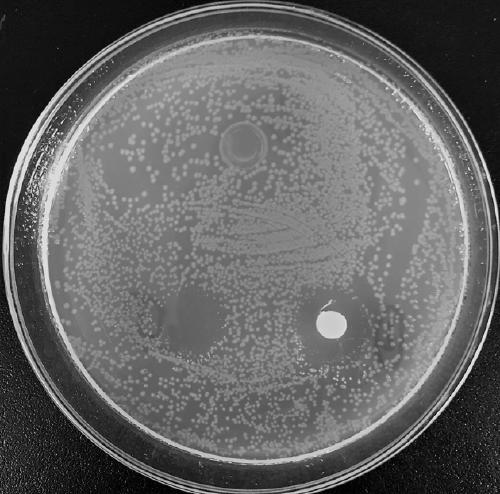Bacteriocin produced by Bacillus coagulans and application thereof
A technology of Bacillus coagulans and bacteriocin, applied in the field of microorganisms, can solve problems such as poor stability, and achieve good thermal stability, good antibacterial performance, and good probiotic effect
- Summary
- Abstract
- Description
- Claims
- Application Information
AI Technical Summary
Problems solved by technology
Method used
Image
Examples
Embodiment 1
[0025] Example 1 Isolation and Identification of Bacillus coagulans CGMCC9951
[0026] 1. Isolation and purification of Bacillus: Collect 30 copies of cecum and feces of healthy piglets in ecological farms under aseptic conditions, weigh 1g of the samples and add them to 9mL sterile saline, shake and mix well, and put them in a water bath at 80°C Remove non-spore bacteria in a water bath for 10 minutes, inoculate in the improved LB medium according to the inoculum amount of 1%, incubate at 37°C for 20 hours, and spread on the improved calcium carbonate identification plate; select a single colony with a calcium-dissolving circle and grow well , transferred to the nutrient agar slant with an inoculation loop for pure culture, repeated subculture for 3 times, and stored in a 4°C refrigerator for later use.
[0027] 2. Observation of bacterial colony morphology: activate the slant bacterial species preserved in step 1 for 2-3 times, take a clean glass slide and carry out Gram sta...
Embodiment 2
[0033] Example 2 Stress resistance verification of Bacillus coagulans CGMCC NO.9951
[0034] 1. Tolerance test of simulated gastric acid: Inoculate Bacillus coagulans with the preservation number CGMCC NO.9951 in LB medium, culture at 37°C for 36 hours, and centrifuge the bacterial solution at 5000 rpm for 10 minutes to collect the bacterial cells. The same amount of bacteria was added to 10 mL of sterile PBS buffer with pH 1, 2, 3, 4, 5 as the test group; the bacteria were added to 10 mL of sterile PBS buffer with pH 7.0 as the control group. The above-mentioned treated samples were cultured statically at 37° C. for 2 hours, and counted on plates. The survival rate was the ratio of the number of live bacteria in the experimental group to the control group multiplied by 100%. The results showed that the survival rate was 91±3.5% at pH 4 after being exposed to the extreme condition of pH 1-2 for 2 hours. It can be seen that Bacillus coagulans has strong acid resistance and ca...
Embodiment 3
[0037] Determination of embodiment 3 bacillus coagulans optimal antibacterial effect culture time
[0038]Inoculate Bacillus coagulans CGMCC NO.9951 into the optimized LB medium, culture at 230rpm, 37°C for 16h, start at 16h of culture, take samples at intervals of 8h, continue sampling until 56h of culture, and take samples 6 times in total. The cell-free fermentation supernatant was obtained by centrifugation at 4000rpm, and the diameter of the inhibition zone was measured by using the Oxford cup antibacterial test method. Each group of experiments was repeated three times, and the average value of the diameter of the inhibition zone was taken. The results show that the antibacterial activity of the cell-free supernatant of Bacillus coagulans CGMCC9951 increases continuously with the growth of culture time, and its antibacterial activity reaches the maximum at 48 hours. The results are shown in Figure 6 .
PUM
 Login to View More
Login to View More Abstract
Description
Claims
Application Information
 Login to View More
Login to View More - R&D
- Intellectual Property
- Life Sciences
- Materials
- Tech Scout
- Unparalleled Data Quality
- Higher Quality Content
- 60% Fewer Hallucinations
Browse by: Latest US Patents, China's latest patents, Technical Efficacy Thesaurus, Application Domain, Technology Topic, Popular Technical Reports.
© 2025 PatSnap. All rights reserved.Legal|Privacy policy|Modern Slavery Act Transparency Statement|Sitemap|About US| Contact US: help@patsnap.com



